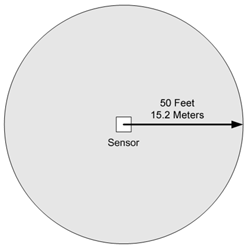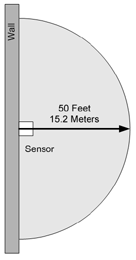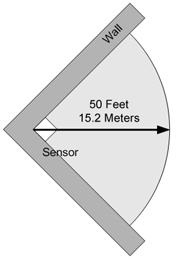The following recommendations apply to all BAPI gas sensors (Volatile Organic Compound, Carbon Dioxide, Carbon Monoxide, Nitrogen Dioxide, Particulate and Refrigerant). These recommendations provide the maximum coverage area in ideal conditions. Installations vary due to obstructions, furniture, walls and air currents in your facility. If you are in doubt about providing adequate coverage in your building, it is prudent to add another sensor or sensors.
Many cities, towns or other local jurisdictions may have their own regulations governing coverage area and sensor mounting. Follow local regulations where they are more stringent.
COVERAGE AREA
Assuming still air, in an open area, BAPI’s gas sensor coverage area is 7,800 ft² (725 m²) maximum. The coverage area is roughly a circle with the sensor in the center. A 7,800 ft² (725 m²) circle is 100 feet (30.5 meters) in diameter. One example of this is a Carbon-Monoxide sensor mounted to a support column in the middle of a parking garage.
If the sensor is mounted on a wall, the area is half, roughly a half circle. If the sensor is mounted in a corner, where two walls meet, the area is one fourth, roughly a quarter circle. If the area is broken up by partition walls that extend from the floor to a height of 4 feet (1.2 meters) or more, the coverage area is only that of the “room”. If the room is larger than 7,800 ft² (725 m²) more than one sensor will be needed.
If you place a sensor in a small closet, the coverage area is only the closet.



SENSOR MOUNTING
Mount the sensor away from supply air diffusers. Mounting sensors near return air diffusers may be beneficial if the air currents do not dilute the contaminant concentration. Any air currents in your building may cause accumulation of gasses in a particular area; it is prudent to mount a sensor in these areas. Chemical smoke may be used to visualize the air currents.
Gas sensors should be solidly mounted to a non-vibrating surface. If conduit is used for wiring, the conduit must be sealed after wiring to prevent air movement through the conduit.
Volatile Organic Compound, Carbon Dioxide, Carbon Monoxide, Nitrogen Dioxide and Particulate sensors should be mounted 3 to 5 feet (0.9 to 1.5 meters) above the floor level. Refrigerant sensors should be mounted 18 inches (45 cm) above the lowest level of the equipment’s location.
If you have any additional questions about BAPI Air Quality Sensors, please call or email your BAPI representative.



